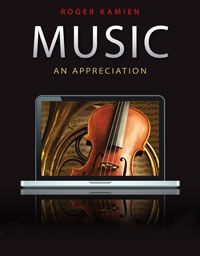
Music: An Appreciation, 10th Edition (Kamien)Chapter 1: Sound: Pitch, Dynamics, and Tone ColorInteractive ChapterELEMENTS OF MUSIC: SOUNDSounds bombard our ears every day--the squeaks and honks of traffic, a child's laugh, the bark of a dog, the patter of rain. Through them we learn what's going on; we need them to communicate. By listening to speech, cries, and laughter we learn what others think and how they feel. But silence, an absence of sound, also communicates. When we hear no sound in the street, we assume no cars are passing. When someone doesn't answer a question or breaks off in the middle of a sentence, we quickly notice, and we draw conclusions from the silence. Sounds may be perceived as pleasant or unpleasant. Fortunately, we can direct our attention to specific sounds, shutting out those that don’t interest us. At a party, for instance, we can choose to ignore the people near us and focus instead on a conversation across the room. Actually, we shut out most sounds, paying attention only to those of interest. The composer John Cage (1912-1992) may have meant to show this with his "composition" entitled 4’33, in which a musician sits at a piano for 4 minutes and 33 seconds--and does nothing. The silence forces the people in the audience to direct their attention to whatever noises, or sounds, they themselves are making. In a sense, the audience "composes" this piece. To get the effect, listen to the sounds that fill the silence around you right now. What are these sounds that we hear? What is "sound"? What causes it, and how do we hear it? Enter here to review the Elements of Music: Sound.(The interactive chapter will open in a new window.) Note: If the Interactive Chapter does not open, you may have a pop-up blocker running. Please make sure to allow pop-ups for this website. Consult your browser's help documentation if you are unsure how to do this. |  |















